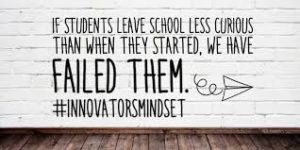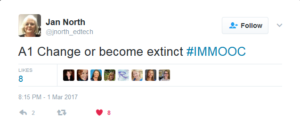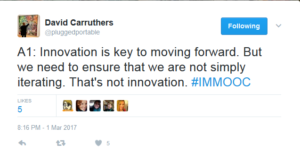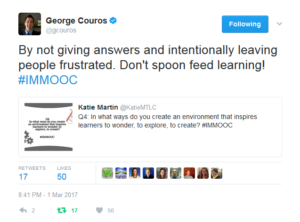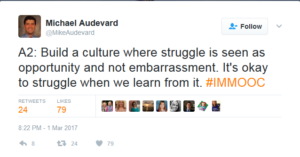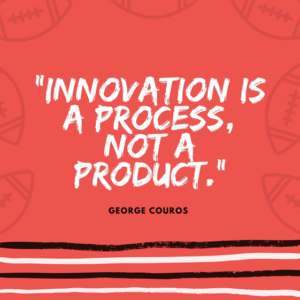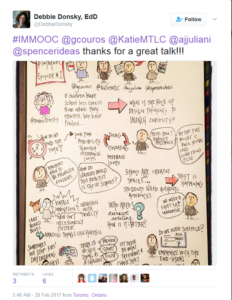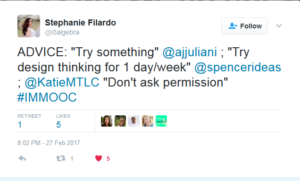Live Session 4 with George Couros, Katie Martin and special guest, Jennifer Casa-Todd.
[youtube https://www.youtube.com/watch?v=ZSzmdE_tnSM&w=560&h=315]
Jennifer Casa-Todd joined us in this week’s live session with her passion to “bring the students to the world in which they live”. If they are living in social media why are we not allowing them to go there in their learning experiences? We will find more on this topic when her book, Social Leadia, is published. Jennifer sends the message that we need to prepare our students with the skills to appropriately use social media. She adds that we need to empower them to be the “first responders” and take the lead in helping others recognize appropriate and positive uses. She calls this being taught digital leadership which extends beyond digital citizenship.
George has a blog on the topic of “Helping Students Develop Their Online Identity” where he explains the “3 Things Students Should Have Before They Leave High School”. In this blog he mentions Jason Shaffer and how his school in Coconut Creek, Florida has a required course starting in grade 9 called Personal Branding and Digital Communication. The message of this course is “Identify your passions, stick to your moral code, focus on your goals and tell your personal story through a variety of social platforms.”
Katie tells us the best way to begin taking kids to social media in school is in first having a conversation of what to you want kids to know, understand and be able to do. Then you find the best tools in technology to fit those needs to get the kids to those goals. She adds that we have to move from a culture of fear with what kids can do on social media and shift it to a culture of believing in the positive of how they can do amazing things. She reminds us of the importance of revisiting our vision and ask ourselves how we are doing in making progress toward our goals and share what is and is not working to enhance success. Remember, our intent needs to have an impact.
George adds that it is important that all stakeholders are clear on the vision you have for the students so we are on the same route and not making it messy and confusing. Thank you George for adding that those that fear technology aren’t veteran teachers. It has nothing to do with age, but in the mindset one has. “It is how you think and do stuff.”
George challenges us to make their learning public so we can shift the conversations at home from, “What did you learn about today?” to “I saw what you learned today.”
Matt Arend Tweeted out this popular statement:
You @Google restaurants to eat at, but won't google your child's teacher? Why? Will you find anything? #BuildYourBrand #IMMOOC
— Matthew Arend (@matthew_arend) March 21, 2017
Here is Lalonnie King’s and Debbie Donsky’s sketch note summaries of Live Session 4:
Another great live episode for #IMMOOC! !! pic.twitter.com/pRdB5jawn9
— Lalonnie King (@LalonnieK) March 21, 2017
#IMMOOC @JCasaTodd @gcouros @KatieMTLC season 2 episode 4 pic.twitter.com/NWEzGBCEOy
— Debbie Donsky, EdD (@DebbieDonsky) March 21, 2017
IMMOOC participants also enjoyed Stephanie Filardo’s post which looks like the perfect meme to use again when this session comes to a close.
When you won't be home in time for #IMMOOC live and don't want to miss a thing @JCasaTodd @KatieMTLC @TaraMartinEDU @gcouros say! pic.twitter.com/KLcocPy3mH
— Stephanie Filardo (@i3algebra) March 20, 2017

Examples of setting the foundation for innovation. Examples of strengths-based leadership to unleash talent and foster innovation.
In Chapter 8, George makes this statement: “What if we stopped operating on a deficit model that focuses on a learner’s weaknesses and started operating on a strengths-based model that builds on the learner’s strengths?” How can we utilize the strengths and expertise of the people in our very classrooms or buildings?
Amber McMath’s blog entitled “Strength-based Blah Blah Blah” will resonate with you as she says that we all know relationships are important, but we need to go beyond knowing someone’s favorite color. “We need to know them deeper in order to provide strength based learning experiences.” She leaves you reflecting on these “What If?” thoughts:
What if…
- It wasn’t just another “strengths-based blah blah blah” workshop I had to go to about being warm and fuzzy but rather a philosophical paradigm shift that touched every part of our school culture?
- Teachers purposefully met individually with struggling students to encourage them specifically on what they’d done well that day?
- Students were not punished for being behind in reading by having an elective class taken away?
- Principals personally asked every staff member in their building, “What is your dream job? Where do you see your career in a few years?”
- Superintendents invited a teacher, student, or parent to shadow them all day and see the nitty gritty behind the big decisions that affect everyone?
- Instead of solely focusing on all the parts of the school that need be fixed, we celebrated the parts that shined?
- We didn’t just say, “My door’s always open!”? What if we meant it enough that we invited people in to tell them how amazing they are, how valued they are, how sincerely thankful we are for what they bring to the table?
Mena Hill made connections of strength based learning with herself and the Wizard of Oz in her blog, “Leading, Learning, and Growing – Oh, My!”
Not only do I want to challenge my own thinking, but also the thinking of colleagues and my students. If a person is successful in a certain area and wants to explore more, why not? Isn’t that the point of learning and growing? “Bringing people’s strengths to life” challenges us all to engage in a conversation. Throughout The Wizard of Oz Dorothy asks questions of her friends to not only find out “what” makes them tick, but also “why” they want to grow. When the main characters discovered their true strengths, they are filled with confidence. So start with asking yourself what are your strengths and do your colleagues and students a favor, ask them too.
Kris Kampovitz reflects on the lesson learned of “less is more and focus” is necessary to foster innovation in her blog this week.
I, too have constantly sent emails with links to blogs, articles and research to my teachers. Links that contain fantastic strategies, ideas, plans etc.. for content and concepts they’re teaching or things with which they’re struggling. I incorrectly assumed that my own enthusiasm and passion for this information would be just as greedily consumed by everyone. What I found out was just the opposite. I had sent so many over the course of a few months that teachers either read only one or two, didn’t even open them, or deleted them all together! Seriously? Why? It was because I, too, didn’t have a focus for the content I was sending. I had sent a hodgepodge of everything and anything I’d come across on Twitter, Youtube, or www.fillintheblank. With everything teachers had going on, more emails from me certainly didn’t make it to the top of their priority list. What I have learned, and what was hammered home by Chapter 10, was that teachers want and need these resources, but the resources need to apply to them specifically.
Here is a popular Tweet in our #IMMOOC chat this week from Kirsten Hund:
A6: We only have so much time in the day – you have to stop doing things that are not adding value to do more of what is. #LetItGo #IMMOOC
— Kirsten Hund (@khund) March 23, 2017
Gilles Thériault put together this Storify for us based on the @IMMOOC chat on what we can do less so we can dig deeper. (He made a Storify for all of our responses to this week’s #IMMOOC chat. Check it out on his Twitter page.)
A6 #IMMOOC March 22, 2017 https://t.co/k8Kxmhyx0a via @gillestheriault
— Gilles Theriault (@GillesTheriault) March 23, 2017

Examples of Innovative elements in today’s Professional Learning.
George provided us with an opportunity for innovation when he challenged us to find a blog buddy when reflecting on this week’s reading over Part 3. How many of the elements of an innovative classroom did we use in this activity? How can we provide this opportunity for our students?
Jamie Wiitala’s blog entitled “Time for Reflection” confirms the need for a foundation of relationships in order to get others on board to move out of the “comfort bubble” and allowing time to reflect has accelerated the process. You will love her approach to getting others to change when she says, “You are fine where you are at, you just can’t stay there.”
As our teacher evaluation program continues to evolve, more and more teachers are becoming open to the idea of other teachers coming into observe and collaborate with them. It makes me sad to see teachers that isolate themselves and have not experienced the amazing thing that is collaboration. Having the time set aside in our observation cycles for dedicated reflection on their teaching is helping them see the benefits of talking to other professionals and growing together. Once they realize that we are there as a support system and we are not doing anything evaluative they ease up and participate in the conversation.
She also adds the benefit of Tweeting out and reading for 5 minutes each day on a group # which she discovered on Twitter.
I started a school hashtag, #STMAshares, where my team of instructional coaches started tweeting the things we see in classrooms along with new resources and ideas we are researching. I have taken time to find the best hashtag’s and the greatest minds to follow. I try and post every day with things I see, read or try on my own.
April Padalino refers back to strength-based learning in guiding professional learning in her blog, “Stretch Strengths”.
The same can be said when working with adults. It is important to build on strengths and show people the way to growth. George Couros states in his book ” Focusing on individuals’ strengths that contribute to the vision of the school helps to move us from pockets of innovation to a culture where innovation flourishes.” I can see this happening in our district. We have been offered opportunities three times this year to share what we are passionate about through a workshop model of professional development. We are given the choice how to best spend our time on those days by presenting, attending, collaborating, reflecting, or a combination of these. While working on the new strategic plan the district asked the staff the question, “If you could create a school, what would it look like?” I have to say it was nice to be asked. Our district appears to be working toward creating a culture of innovation. I am looking forward to where it will lead.
Did you catch this highlight during Week 4? Our very own #IMMOOC chat co-moderators met face-to-face for the first time.




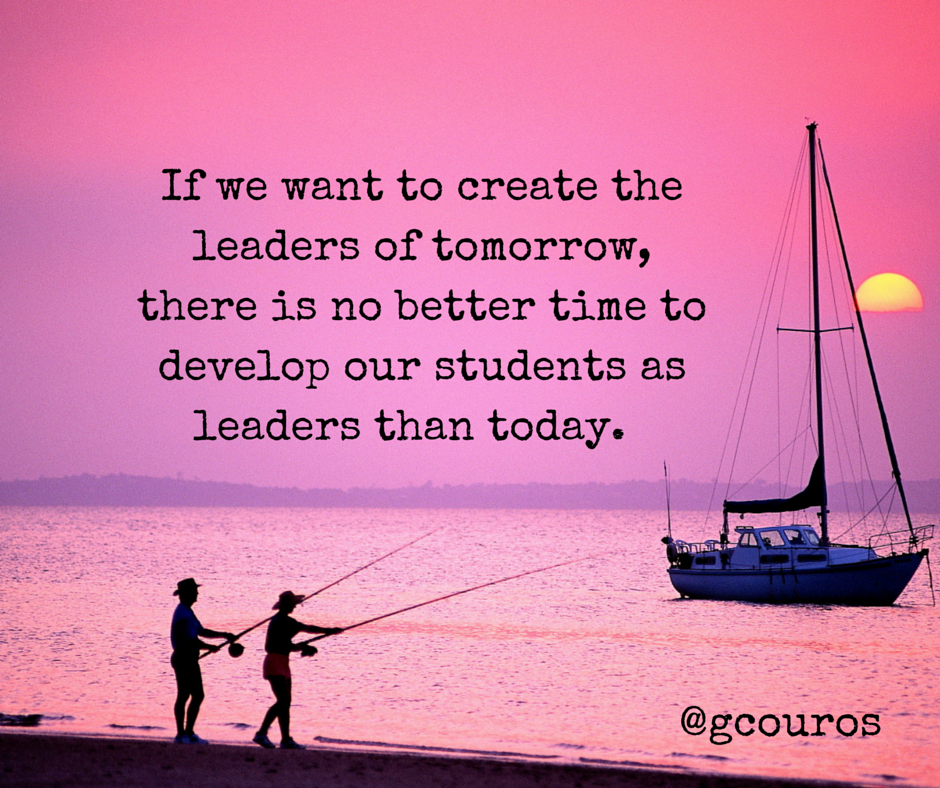
 This is a compilation of some highlights in our second week of Innovator’s Mindset MOOC Round 2 #IMMOOC2. To join the conversation, check out
This is a compilation of some highlights in our second week of Innovator’s Mindset MOOC Round 2 #IMMOOC2. To join the conversation, check out 

